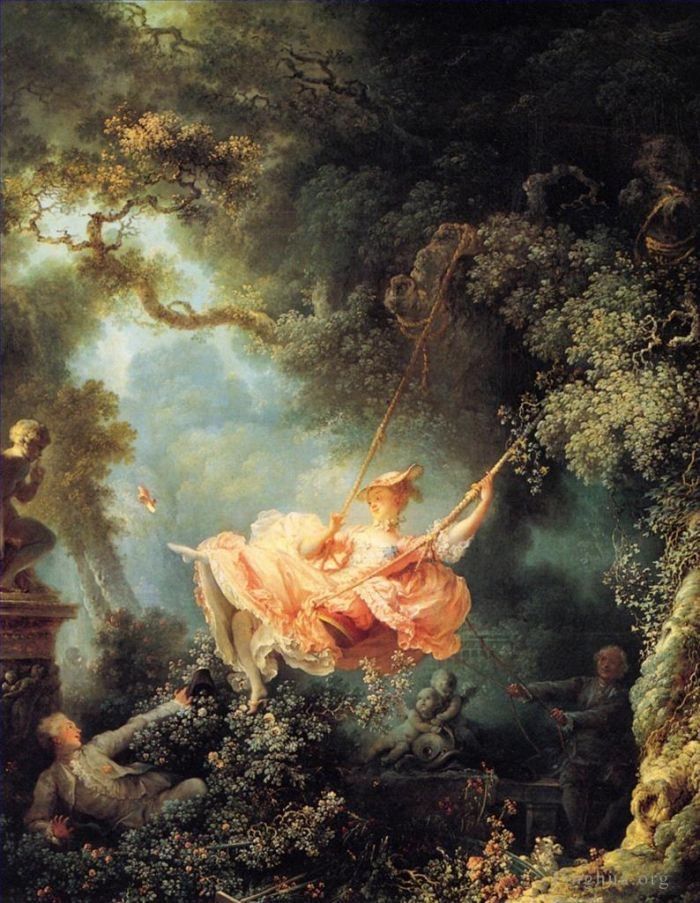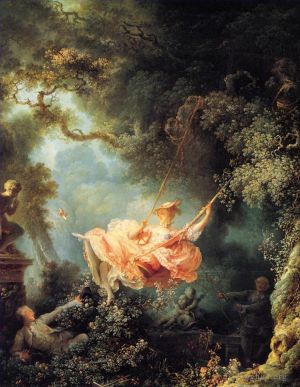The Swing
Jean-Honore Fragonard
- Price: Price on Request
- Art Type: Oil Painting
- Size:
- English Comments: 0
- International Comments: 0
- Creating Date:
- Introduction and Works of Jean-Honore Fragonard >>
Keywords:
Swing
Work Overview
- The Swing (The Happy Accidents of the Swing)
L'Escarpolette (Les Hasards heureux de l'escarpolette)
Artist Jean-Honoré Fragonard
Year ca. 1767
Medium Oil on canvas
Dimensions 81 cm × 64.2 cm ( 31 7⁄8 in × 25 1⁄4 in)
Location Wallace Collection, London, United Kingdom
The Swing (French: L'Escarpolette), also known as The Happy Accidents of the Swing (French: Les Hasards heureux de l'escarpolette, the original title), is an 18th-century oil painting by Jean-Honoré Fragonard in the Wallace Collection in London. It is considered to be one of the masterpieces of the rococo era, and is Fragonard's best known work.
The painting depicts an elegant young woman on a swing. A smiling young man, hiding in the bushes on the left, watches her from a vantage point that allows him to see up into her billowing dress, where his arm is pointed with hat in hand. A smiling older man, who is nearly hidden in the shadows on the right, propels the swing with a pair of ropes. The older man appears to be unaware of the young man. As the young lady swings high, she throws her right leg up, allowing her dainty shoe to fly through the air. The lady is wearing a bergère hat (shepherdess hat). Cupid watches the affair at the side of the painting, while putting his finger to his lips. There are also two cherubs below the swing. One of them look away in disapproval while the other look at them in dread. According to the memoirs of the dramatist Charles Collé,[2] a courtier (homme de la cour)[3] asked first Gabriel François Doyen to make this painting of him and his mistress. Not comfortable with this frivolous work, Doyen refused and passed on the commission to Fragonard.[2] The man had requested a portrait of his mistress seated on a swing being pushed by a bishop, but Fragonard painted a layman.
This style of "frivolous" painting soon became the target of the philosophers of the Enlightenment, who demanded a more serious art which would show the nobility of man.
The original owner remains unclear. A firm provenance begins only with the tax farmer M.-F. Ménage de Pressigny, who died in 1794, after which it was seized by the revolutionary government. It was possibly later owned by the marquis des Razins de Saint-Marc, and certainly by the duc de Morny. After his death in 1865 it was bought at auction in Paris by Lord Hertford, the main founder of the Wallace Collection.
There are two notable copies, neither by Fragonard.
One, once owned by Edmond James de Rothschild,[6] is slightly different from the original: the lady's dress is blue, not pink[7]
The other is a smaller version (56 × 46 cm), owned by Duke Jules de Polignac.[6] This painting became the property of the Grimaldi family in 1930 when Pierre de Polignac (1895-1964) married Princess Charlotte, Duchess of Valentinois (1898-1977). In 1966, it was given by the Grimaldi & Labeyrie Collection to the city of Versailles, where it is currently exhibited at the Musée Lambinet, attributed to Fragonard's workshop.
Fragonard's scenes of frivolity and gallantry are considered the embodiment of the Rococo spirit. A pupil of Chardin and later Boucher, he won the Prix de Rome and from 1756 to 1761 was in Italy, where he developed a particular admiration for Tiepolo and the late Baroque style. In this period he specialized in large historical paintings.
Returning to Paris, he soon changed this style, adopting instead the erotic subjects then in vogue and for which he is chiefly known, of which The Swing is the most famous.
This picture became an immediate success, not merely for its technical excellence, but for the scandal behind it. The young nobleman is not only getting an interesting view up the lady's skirt, but she is being pushed into this position by her priest-lover, shown in the rear.
In this same spirit are some other famous pictures, The See-Saw, Blindman's Bluff, The Stolen Kiss, and the Meeting. After his marriage in 1769, he began painting children and family scenes (usually called genre painting) and even returned to religious subjects. He stopped exhibiting publicly in 1770 and all his later works are commissions from private patrons.
To many, this painting embodies the entire spirit of the ancien regime on the eve of the revolution. What elements do you find representative of French society and morals?
---------------------
Commissioned by the notorious French libertine Baron de St. Julien as a portrait of his mistress, The Swing was to be painted to the following specificity: "I should like you to paint Madame seated on a swing being pushed by a Bishop. "
While this odd request was turned down by other painters such as Doyen, a painter of more serious historical subjects, Fragonard leapt to the occasion, producing what became the most iconic work of the French Rococo.
In the foreground the playboy Baron himself is depicted, reclining in the lush shrubbery, one arm outstretched towards the maiden's skirts, his other arm holding his balance. He gave very specific instructions to Fragonard, stating "Place me in a position where I can observe the legs of that charming girl. "
His mistress flies through the air on a sylvan swing, the lovely young lady giving herself away to frivolous abandon, her shoe flying off in the heat of the moment.
In the background of the composition one can see what was originally going to be the Bishop requested by the perverse Baron, but which was changed to the mistress's husband by Fragonard. The husband plays a lesser role, being immersed in shadow while the Baron is illuminated under the maiden's dress.
The inanimate objects add to the story as well. Two cherubs below the swing appear concerned by the sordid actions of the humans above them, one looking up at the women in trepidation and the other looking away from the action with a scowl. On the left side of the image is a stone statue of Cupid who raises a finger to his lips to point out the secretive nature of the impending affair.
Overall Fragonard's The Swing, rich with symbolism, not only manages to capture a moment of complete spontaneity and joie de vivre, but also alludes to the illicit affair that may have already been going on, or is about to begin.
Considered to be Fragonard's most successful painting, The Swing stands alone today as an emblem of Rococo art. The combination of insouciant attitude, tongue-in-cheek eroticism, pastel swirls, and pastoral scenery creates an irresistible testament to the beauty of youth and illegitimate affairs. In Fragonard's world, adultery is but a devilishly gay way to pass the time.
Francois Boucher:
One of Fragonard's first teachers, the art of Francois Boucher seems to have made an impression on the young painter, and can be seen in such erotic confections as The Swing.
Boucher specialized in the combination of the pastoral scene with a passionate sensibility. While originally commissioned to paint mythological scenes, Fragonard had a knack for turning them into more of a boudoir scene in open air and this cheeky sensibility is reflected in The Swing.
Peter Paul Rubens:
Always a fan of the Dutch Masters, the inspiration that Rubens provided is clear in this portrait with its attention to detail, loose fluid brushwork, and freewheeling attitude of the scene.
In addition, the Dutch of this time period were notorious for their inclusion of small symbolic items, which appear in The Swing in the case of the embracing putti and Cupid with his finger over his lips, to symbolize the secrecy of the affair. These are all reminiscent of earlier works by Rubens.
School of Fontainebleau:
The infamous French palace, decorated in the late 1500s by a group of painters headed by Rosso Fiorentino, specialized in eroticizing the mythological or classical subjects that were requested for the aristocrats of the time, serving as a precursor for the fanciful tastes that the later nobles would request.
Women at their bath, saucy portraiture, and pastoral settings were all seen here. The Swing would have fitted in perfectly.
Fragonard painted The Swing with the intention of flattering the Baron and his mistress, to supply them with a lighthearted, frivolous painting and to provide an intimate memento of their relationship. To this end, he utilized only the finest of the Rococo techniques.
Composition:
The Swing is composed in a triangular shape, with the Baron and the husband forming the base of the pyramid, and the maiden in the air at the top of the triangle, in the center of the space.
She is illuminated by the soft lighting coming from above, and the fanciful trees form an oval frame for the action in the center.
Fragonard included a number of hidden details within the composition to heighten the message of playful love, including two putti embracing, a stone lap dog and dolphin, and a stone statue of Cupid.
The lady's slipper, which flies off her foot as she swings so easily, is another playful touch which helps accentuate the erotic subject matter, as well as providing a visual focus in the splash of sunlight.
Color Palette:
The Rococo style attempted to appeal more to the sensual rather than the intellectual side. As a result Fragonard utilized a delicate pastel color palette that would be just as at home in a cupcake shop as on canvas, with frothy creams, juicy pinks, and minty greens.
Lighting:
For this outdoor scene, Fragonard utilized a soft dappled sunlight filtering through the trees and backlighting them, infusing the scene with a soft, seductive glow. The light hits the young lady on the swing, highlighting her fair skin and the creamy billows of fabric that swirl around her.
In contrast, other aspects of the painting remain in shadow, such as the husband, possibly referencing his being "in the dark" as to his wife's affair.
Tone and Mood:
The mood in the painting is lighthearted and gay. The overall effect is one of erotic mirth and frivolity, typical of Rococo works. The contrast between light and shadow adds to the feeling that something illicit is taking place.
Brushstroke:
Emphasizing the free and easy nature of the subject matter, Fragonard uses a fluid, loose brushstroke, keeping the edges soft with regards to his main figures. In comparison to many of his other works however, he paints with a finer detail than usual, reminiscent of 17th Dutch masters such as Rembrandt.
- Copyright Statement:
All the reproduction of any forms about this work unauthorized by Singing Palette including images, texts and so on will be deemed to be violating the Copyright Laws.
To cite this webpage, please link back here.
- >> English Comments
- >> Chinese Comments
- >> French Comments
- >> German Comments
- >>Report
- The Swing
- The Bathers
- The Lock
- Psyche and her two sisters
- Young girl reading
- The Storm
- Portrait of a Man
- Portrait of a Young Man
- A Boy as Pierrot
- Adoration of the Shepherds
- Marie Madeleine Guimard Dancer
- The Confession of Love
- Portrait of a man called the warrior
- The Small Park (Le petit parc)
- The Fountain of Love
- Music Lesson
- The Love Letter
- Young Woman Playing with a Dog
- A Young Scholar
- Coresus Sacrificing himselt to Save Callirhoe
- The Souvenir
- The Shepherdess
- Venus and Cupid
- Man Playing an Instrument The Music
- The Stolen Kiss
- Psyche showing her Sisters her Gifts from Cupid
- The Musical Contest









 Singing Palette
Singing Palette